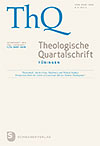archivierte
Ausgabe 1/2025 |


 |
      |
 |
|
|
|
|
 |
|
| Leseprobe 2 |
DOI: 10.14623/thq.2025.1.59–73 |
|
| Janet Okang |
| Lunching With the Boss |
| Reimagining Famine, Fields, and Food in the Book of Ruth |
 |
Zusammenfassung
Der Verlust und die Wiedererlangung von Nahrung prägen die Erzählung von Ruth. Traditionell wird Ruth als heterosexuelle Romanze gelesen, die die unwahrscheinliche Verbindung eines wohlhabenden Farmbesitzers – Boas – mit einer armen Witwe – Ruth –, einer Ausländerin aus dem Volk Moab – hervorhebt. Infolgedessen wurden analytische Lesarten überdeckt, die sich mit (Un-)Gerechtigkeit bezüglich der Verteilung von Nahrungsmitteln, Ausbeutung und hierarchischen Strukturen befassen. Jüngste Forschungen versuchen jedoch, dieses Narrativ zu verändern, indem sie darauf hinweisen, dass eine Hungersnot die Geschichte auslöst und der Hunger die Handlung antreibt.
Die vorliegende Studie lenkt die Aufmerksamkeit auf Nahrung/Brot als das wesentliche Motiv in der Erzählung von Ruth. In Anwendung dekolonialer Theorie und Ghanaischer kontextueller Hermeneutik lässt sich darlegen, dass das, was auf Boas’ Feld geschieht, Entfremdung und Spaltung ist; es werden hierarchische Sozialsysteme (z. B. Geschlechterungleichheit und Othering) aufgedeckt. Schließlich wird argumentiert, dass soziale Hierarchien abgeschafft werden, wenn sowohl die Reichen als auch die Armen konsequent gemeinsam aus derselben Schüssel am „Tisch“ essen; dies kann Veränderungen bei Einzelpersonen und in der Gesellschaft bewirken.
Abstract
The departure and return of food shape the narrative of Ruth. Traditionally, Ruth is read as a heterosexual romance that highlights the unlikely joining of a wealthy farm owner – Boaz – with a poor widow – Ruth, a foreigner from the nation of Moab, thus overshadowing analytical readings that address food (in)equity, exploitations, and hierarchical structures. However, recent scholarship attempts to change this narrative by pointing out that famine launches the story and hunger drives the plot.
The present study draws attention to food/bread as the significant motif of Ruth’s narrative. Through decolonial theory and Ghanaian contextual hermeneutics, the paper proposes that what transpires at Boaz’s field is alienation and division; hierarchical social systems (e. g., gender inequality and othering) are revealed. Finally, the study proposes that social hierarchies are abolished when both the haves and have-nots consistently eat together from the same bowl at the “table;” this can bring changes in individuals and societies.
Schlüsselwörter/Keywords
Ruth; Hungersnot; Felder; Plantagen; Nahrung; (de)kolonial; Hierarchie; Othering; Kommensalität; Entkolonialisierung der Mahlzeiten
Ruth; famine; fields; plantations; food; (de)colonial; hierarchy; othering; commensality; decolonizing mealtime
Introduction
The early absence of food unveils Ruth’s tale. By the close of the opening chapter, food returns to Bethlehem, as do Naomi, Ruth, and the harvest (1:22). Midway through, Ruth, a Moabite at Boaz’s field, is invited by Boaz, a worthy farm owner, to table fellowship and to glean freely at Boaz’s plantation. The event at the plantation has been the subject of numerous interpretations that quickly ignore that agriculture, which in antiquity was about power, is at the story’s core. Traditionally, Ruth is interpreted as a heterosexual romance between a wealthy farm owner, Boaz, and a poor widow, Ruth, a foreigner, with Naomi as the mediator of this telenovela love epic. Despite recent scholarly attempts to change this narrative, most commentaries gleaned alongside the “love bubbles” of Ruth, neglecting the theme of famine, hunger, and food within their power structures. Feeding off those who have highlighted labor, class, gender, ethnicity, and food security in Ruth, this essay focuses on food as a central element, and explores its departure and return as key to the plot. It highlights the issues of food (in) security and (in)equity that cast a shadow over Ruth, and posit that Ruth 2–3 can be a resource for engaging with such issues in the twenty-first century. Utilizing decolonial theory and Ghanaian contextual hermeneutics, the paper posits that the alienation and division inherent in plantation life can reinterpret Boaz’s land ownership and management.3 Employing Frantz Fanon’s concept of the colonial world, the paper reimagines Boaz’s fields, exploring social hierarchies, their impact on character behavior, social interactions, and whether Ruth upholds or challenges these hierarchies. Consequently, the research question is: can this analysis, with the potential to reveal a harsher reality, offer subversive glimpses of an alternative social order, suggesting a more liberating social vision, inspired by Ghanaian practices?
“There was a Famine in the Land”
If you Want to Understand the End, Look at the Beginning
In chapter 1, Ruth opens with famine ( רָעָָבָ ) – where both people and land are traumatized, and the effect of trauma and flashbacks of hunger remain within the body and land. Like others in Africa, Ghanaians will associate this kind of disaster with the absence of the G/gods who are not pleased with the transgressions of the people.4 Therefore, the need for animal sacrifices and rituals of atonement. With such an understanding also common in the Bible (e. g., Jer 24:10; 44:13, Ezek 5:11–17, 14:13, Amos 4:6–9), one might interpret the story’s opening words as implying that God has vacated Bethlehem due to the nation’s sins. [...]
Lesen Sie den kompletten Artikel in der Printausgabe.
|
|
|
|
|
|
|
Anzeigen
|
Mit Anzeigen und Inseraten erreichen Sie Ihre Zielgruppe. Anzeige aufgeben
|
 |
|
Unsere Dienstleistung für Verlage, die Ihr Abogeschäft in gute Hände geben wollen.
|

mehr
Informationen
|
 |
|
| Bücher & mehr |

|
|

